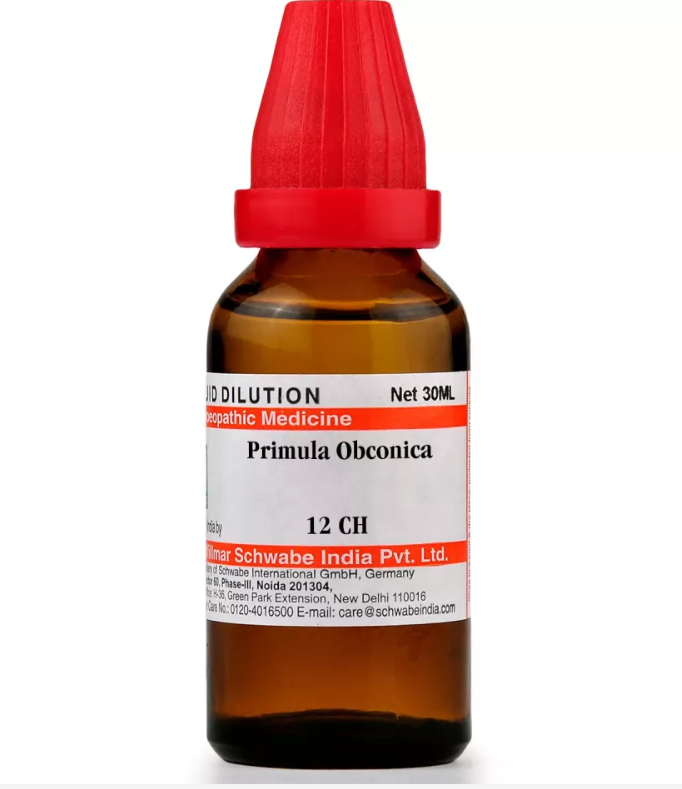PRIMULA OBCONICA Q, 6C, 12C, 30C, 200C, 1M, 10M USES AND SYMPTOMS
 PRIMULA OBCONICA
PRIMULA OBCONICA
(Primrose)
Prim-o.
The toxin in Primrose is found in its glandular hairs, which easily break and release an irritating fluid absorbed through the skin. Sensitive individuals may experience skin reactions without direct contact, as mere proximity to the plant can trigger symptoms, similar to Poison Ivy. Symptoms tend to be intermittent, worsen on the right side, and may include liver and spleen pain, deep tissue infiltration, blisters, a paralyzed sensation, and weakness. Pharyngeal soreness may alternate with reduced facial irritation.
Face: Moist eczema, papular chin eruptions, nighttime burning, and urticaria-like rashes. Swollen eyelids.
Extremities: Eczema on the arms, wrists, forearms, and hands, with papular and excoriated areas. Rheumatic shoulder pain, dry and hot palms, joint and finger cracking, eruptions between fingers, purple blotches on the back of hands, and stiff palmar surfaces. Blisters on fingers.
Skin: Severe itching, worse at night, with redness and swelling resembling erysipelas. Tumefied areas with small papules on a raised base, accompanied by febrile symptoms.
Relationship: Compare with Rhus-t., Fago. (antidotal), and Humea elegans for similar skin symptoms.
SYMPTOMS OF PRIMULA OBCONICA
Face:
Moist eczema.
Papular eruptions on the chin.
Burning sensation at night.
Urticaria-like rash.
Swollen eyelids.
Extremities:
Eczema on arms, wrists, forearms, and hands.
Papular and excoriated skin.
Rheumatic pain around the shoulder.
Dry and hot palms.
Cracking over joints and fingers.
Eruptions between fingers.
Purple blotches on the back of hands.
Stiffness in the palmar surface.
Blisters on fingers.
Skin:
Severe itching, worse at night.
Redness and swelling, similar to erysipelas.
Tumefied areas with small papules on a raised base.
Accompanied by febrile symptoms (fever).
selection of the potency
Individualization:
- Homeopathy is based on the principle of treating the individual, not just the disease. The unique symptoms and characteristics of the person are crucial in determining the most suitable potency.
Intensity of Symptoms:
- The intensity of the symptoms guides the choice of potency. If the symptoms are intense and acute, a lower potency (e.g., 6C, 30C) might be considered. For chronic conditions with less intensity, higher potencies (e.g., 200C, 1M) may be appropriate.
Sensitivity of the Patient:
- Some individuals are more sensitive to homeopathic remedies, while others may require higher potencies. The practitioner considers the patient’s sensitivity when selecting the potency.
Acute vs. Chronic Conditions:
- Lower potencies are often used for acute conditions, while higher potencies may be considered for chronic or long-standing issues.
Previous Response to Potencies:
- The patient’s response to previous homeopathic treatments helps guide the choice of potency. If a particular potency has been effective in the past, it may be repeated or adjusted as needed.
Vital Force and Susceptibility:
- Homeopathy views illness as a disturbance in the vital force. The practitioner assesses the patient’s overall vitality and susceptibility to determine the appropriate potency.
Aggravation or Amelioration:
- The direction of the symptom response (aggravation or amelioration) after taking a remedy can influence the choice of potency.
Miasmatic Considerations:
- In classical homeopathy, the concept of miasms (inherited disease tendencies) is considered. The practitioner take this into account when selecting the potency.
Practitioner Experience:
- The experience and preference of the homeopathic practitioner play a role. Some practitioners may have success with certain potencies based on their clinical experience.
SAFETY INFORMATION
- Do not exceed the recommended dose by physician
- Keep out of the reach of children
- Store in a cool dry place away from direct sunlight
- Maintain half an hour gap between food/drink/any other medicines and homoeopathic medicine
- Avoid any strong smell in the mouth while taking medicine e.g. camphor, garlic, onion, coffee, hing
Medicine images use for reference only selection of homeopathic medicine depends on the individual’s specific symptoms and overall constitution. Moreover, homeopathy is a holistic system of medicine that treats the individual as a whole. In addition to addressing the physical symptoms, it takes into account the emotional and mental state of the person. Consequently, it’s crucial to consult with a qualified homeopathic practitioner for personalized treatment.
The information provided on this website is intended solely for educational purposes. Always seek the advice of your physician or other qualified health provider.
